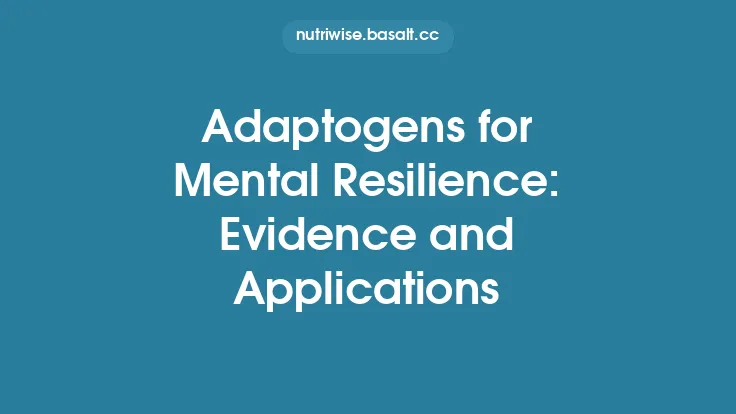Rosemary (Rosmarinus officinalis) has been a staple in Mediterranean kitchens for centuries, prized not only for its aromatic, pine‑like flavor but also for its remarkable effects on brain health. Modern research increasingly supports the traditional belief that this hardy herb can help protect neurons, improve memory, and support overall cognitive function. By integrating rosemary thoughtfully into everyday meals, home cooks can enjoy both its culinary charm and its neuroprotective benefits.
The Phytochemistry Behind Rosemary’s Brain‑Boosting Power
Carnosic Acid and Carnosol
These diterpenes are the primary antioxidants in rosemary. They readily cross the blood‑brain barrier, where they neutralize reactive oxygen species (ROS) and reduce oxidative stress—a key factor in age‑related cognitive decline. In animal models, supplementation with carnosic acid has been shown to preserve synaptic plasticity and improve performance on maze tests.
Rosmarinic Acid
A polyphenolic compound that exerts anti‑inflammatory effects by inhibiting the NF‑κB pathway. Chronic neuroinflammation is implicated in conditions such as Alzheimer’s disease and mild cognitive impairment. Rosmarinic acid also modulates the activity of acetylcholinesterase, an enzyme that breaks down the neurotransmitter acetylcholine, thereby supporting memory formation.
Essential Oil Constituents (1,8‑Cineole, α‑Pinene, Camphor)
These volatile compounds stimulate cerebral blood flow and have been linked to enhanced alertness and mood. 1,8‑Cineole, in particular, has demonstrated modest improvements in cognitive speed in controlled human trials.
Micronutrients
Rosemary provides modest amounts of vitamin C, iron, and calcium, all of which contribute indirectly to neuronal health by supporting overall metabolic function and oxygen transport.
How Rosemary Supports Specific Cognitive Domains
| Cognitive Domain | Mechanism of Action | Evidence Summary |
|---|---|---|
| Memory (working & episodic) | Inhibition of acetylcholinesterase; antioxidant protection of hippocampal neurons | Human pilot studies report improved recall after daily ingestion of rosemary extract for 21 days |
| Attention & Alertness | Increased cerebral blood flow via essential oil inhalation; modulation of catecholamine pathways | Controlled inhalation trials show faster reaction times and higher scores on sustained attention tasks |
| Neuroprotection | Reduction of oxidative damage; suppression of pro‑inflammatory cytokines | Long‑term animal studies reveal decreased amyloid‑β plaque formation with rosemary supplementation |
| Mood & Stress Resilience | Interaction with GABAergic receptors; regulation of cortisol response | Small clinical trials indicate lower perceived stress after regular consumption of rosemary tea |
Culinary Strategies to Maximize Brain Benefits
1. Fresh vs. Dried Rosemary
Fresh leaves contain higher concentrations of essential oils, while dried rosemary retains more stable polyphenols such as rosmarinic acid. Alternating between the two forms ensures a broader spectrum of active compounds.
2. Heat‑Sensitive Timing
- Low‑Heat Applications: Add fresh rosemary toward the end of sautéing, steaming, or finishing sauces to preserve volatile oils that support alertness.
- High‑Heat Applications: Incorporate dried rosemary early in roasting or braising to allow carnosic acid to become more bioavailable through mild thermal degradation, which enhances its antioxidant capacity.
3. Infusion Techniques
- Oil Infusion: Gently warm extra‑virgin olive oil with a few sprigs of fresh rosemary for 5–10 minutes (do not boil). Strain and use the infused oil for drizzling over salads, fish, or whole‑grain toast. The lipid medium improves absorption of lipophilic diterpenes.
- Tea & Decoction: Steep 1–2 teaspoons of dried rosemary in hot water for 5–7 minutes. Adding a splash of lemon juice can increase the bioavailability of rosmarinic acid by creating a mildly acidic environment.
4. Pairing with Complementary Foods
While avoiding overlap with other spice‑focused articles, rosemary pairs naturally with foods rich in omega‑3 fatty acids (e.g., salmon, sardines) and antioxidants (e.g., berries, leafy greens). The combination can synergistically support neuronal membrane integrity and reduce oxidative stress.
Sample Recipes for Brain‑Supporting Meals
A. Rosemary‑Infused Quinoa Pilaf
Ingredients
- 1 cup quinoa, rinsed
- 2 cups low‑sodium vegetable broth
- 2 tbsp extra‑virgin olive oil (rosemary‑infused)
- 1 small onion, finely diced
- 2 garlic cloves, minced (optional)
- 1 tsp dried rosemary, crushed
- ½ cup toasted pine nuts
- ¼ cup chopped fresh parsley
- Salt & pepper to taste
Method
- Heat the rosemary‑infused oil in a saucepan over medium heat. Sauté onion (and garlic, if using) until translucent.
- Add quinoa, stirring to coat each grain. Sprinkle dried rosemary and toast for 1 minute.
- Pour in broth, bring to a boil, then reduce to a simmer. Cover and cook 15 minutes, or until liquid is absorbed.
- Fluff with a fork, fold in pine nuts and parsley, season, and serve warm.
*Why it works:* Quinoa provides complete protein and B‑vitamins essential for neurotransmitter synthesis, while the rosemary‑infused oil delivers lipophilic antioxidants directly to the brain.
B. Lemon‑Rosemary Grilled Salmon
Ingredients
- 4 salmon fillets (≈150 g each)
- 2 tbsp fresh rosemary, finely chopped
- Zest of 1 lemon
- 1 tbsp lemon juice
- 2 tbsp olive oil (extra‑virgin)
- Sea salt & cracked black pepper
Method
- In a shallow dish, combine rosemary, lemon zest, lemon juice, olive oil, salt, and pepper.
- Marinate salmon for 15–20 minutes at room temperature.
- Preheat grill to medium‑high heat. Grill each side 4–5 minutes, or until the flesh flakes easily.
*Why it works:* Salmon supplies DHA, a critical omega‑3 fatty acid for synaptic fluidity, while the lemon‑rosemary glaze adds both antioxidant polyphenols and essential oil vapors that stimulate cerebral blood flow during cooking.
C. Rosemary‑Lemon Yogurt Dip (Brain‑Boosting Snack)
Ingredients
- 1 cup plain Greek yogurt (full‑fat)
- 1 tsp dried rosemary, finely ground
- 1 tsp honey (optional)
- 1 tsp fresh lemon juice
- Pinch of sea salt
Method
- Whisk all ingredients until smooth.
- Chill for 10 minutes to allow flavors to meld.
- Serve with sliced cucumbers, carrot sticks, or whole‑grain crackers.
*Why it works:* Greek yogurt offers probiotics and calcium, supporting gut‑brain axis health, while the rosemary component contributes rosmarinic acid and essential oils in a low‑heat format that preserves their activity.
Practical Tips for Daily Incorporation
| Situation | Suggested Use | Portion Guidance |
|---|---|---|
| Breakfast | Sprinkle dried rosemary on avocado toast or blend fresh rosemary into a smoothie with banana and almond milk. | ½–1 tsp dried or 1 tsp fresh per serving. |
| Lunch | Add rosemary‑infused oil to grain bowls, or toss roasted vegetables (e.g., carrots, sweet potatoes) with fresh rosemary before baking. | 1–2 tbsp oil or 1 tsp dried per 2‑cup bowl. |
| Dinner | Marinate proteins (poultry, fish, tofu) with rosemary, lemon, and olive oil; finish soups with a few fresh leaves for aroma and benefit. | 1–2 tsp dried or 1 tbsp fresh per 4‑serving dish. |
| Evening Snack | Brew a cup of rosemary tea; sip slowly while reading or meditating. | 1–2 tsp dried leaves steeped for 5–7 min. |
Safety Note: While rosemary is generally safe for most adults, excessive consumption (more than 5 g dried per day) may cause gastrointestinal irritation or interact with anticoagulant medications. Pregnant individuals should limit intake to culinary amounts (≈1 tsp dried per day) and avoid high‑dose supplements.
Monitoring Cognitive Benefits
- Baseline Assessment – Record simple metrics such as daily word recall, reaction‑time tasks (e.g., smartphone apps), or mood rating scales before introducing rosemary regularly.
- Consistent Use – Aim for at least 4–6 weeks of daily culinary exposure to allow bioactive compounds to accumulate in neural tissue.
- Re‑evaluation – Repeat the same metrics after the trial period. Many users report modest improvements in short‑term memory and perceived mental clarity.
- Adjustments – If benefits plateau, vary the preparation method (e.g., switch from oil infusion to tea) to expose the body to a broader range of phytochemicals.
Future Directions in Research
- Human Clinical Trials: Larger, double‑blind studies are needed to confirm dose‑response relationships for rosemary’s cognitive effects.
- Standardized Extracts: Development of standardized rosemary extracts (e.g., 40 % carnosic acid) could enable precise therapeutic dosing while preserving culinary versatility.
- Synergistic Food Matrices: Investigating how rosemary interacts with other brain‑supportive nutrients (e.g., flavonoid‑rich berries) may uncover optimal dietary patterns for neuroprotection.
Bottom Line
Rosemary is more than a fragrant garnish; it is a scientifically backed ally for brain health. By understanding the active compounds—carnosic acid, rosmarinic acid, and essential oil constituents—and applying strategic cooking techniques, home cooks can seamlessly weave rosemary into meals that delight the palate and nurture cognitive function. Whether infused in oil, steeped as tea, or sprinkled over a roasted vegetable, this versatile herb offers an evergreen, accessible pathway to support memory, attention, and overall neural resilience.





